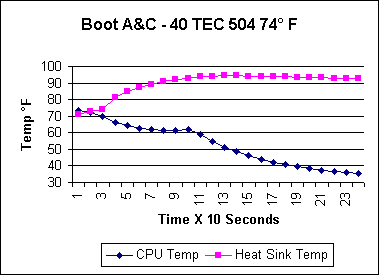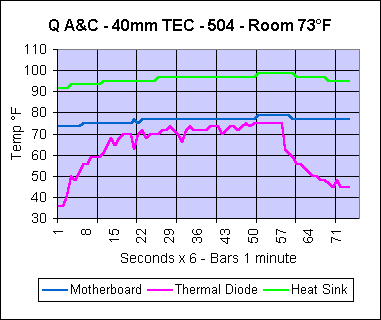
 |


From power off - to booted into windows with Rain running. Rain kicks in at about the 100 second mark. |
You can see how quickly the sink gets warm
from the compounded heat from both the processor and the TEC. Because
of the 1/4" thickness of the cold plate, the processor's slug does not
cool off as quickly as it would with a thinner cold plate. However,
once it does cool off it is a bit more resistant to quick changes in the
processor's temperature. I think the trade-off is a good one as the
temperature at idle has little bearing on how stable the processor will
be when it's working hard.

Windows. Windows with Rain running drops the temperature quickly at just before the 6 minute mark. |
On the Quake2 loop, the Sink and TEC are just holding their own with the internal diode temperature running just a hair over room temperature. After extended periods of time on the Quake2 loop or running Prime95, The internal diode tops out at about 80° F. That was good enough that while running this sink for about a month, I never once had a lock up due to heat. From past experience, I know that my Celeron will lock at about 84 to 86°F in a heavy stress situation.
For this sink, condensation was not an issue. The insulation did its job and there was never as much as dampness on the outside of the foam. This was one of the better things to come out of this project, but I see some more engineering in the works as I add another peltier. As the slug temperatures drop and the temperature of the entire SEPP drops with it, I think that condensation build up inside the slot 1 socket is going to be a problem. I guess I'll cross that bridge when I get to it.
As I said at the beginning of the peltier
part of this project, I had plans to use two TECs instead of just one.
I'm having second thoughts about that. I have the feeling that with
two TECs and the processor all giving off heat inside a closed case, there
is going to be a real issue with case temperature. I'm beginning
to think that water cooling if the way to go.
|
|
|
|